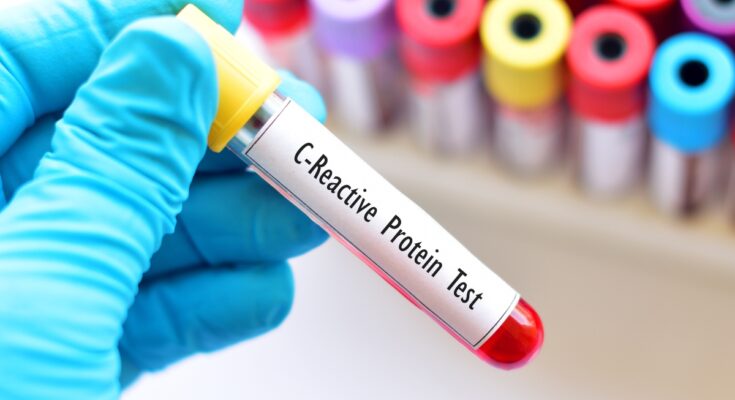PCR (C-Reactive Protein) is a glycoprotein produced in the liver in the event of trauma or infection that triggers inflammatory processes. It is usually not present in the blood or is present in very low quantities. It is therefore released into the blood in case of inflammation from bacterial infections or for a general inflammatory state of the body.
It is therefore one of the most sensitive acute phase indicators. Its plasma levels increase significantly (100-fold or more) after severe trauma, bacterial infections, inflammation, surgery or during tumor proliferation.
It can also be an indicator of cardiac risk, as it is also released into the blood following a heart attack.
The test to measure the molecule consists of a simple venipuncture carried out on an empty stomach and the result arrives after a few days. Of fundamental importance is the CRP index in children and infants, where it comes to play a vital role in understanding the progression of inflammation and predicting its prognosis.
But what does a low or high PCR mean and what are the normal values?
C-reactive protein: what is it?
C-reactive protein (CRP) is a protein produced by the liver in response to inflammation in the body. It is a marker of inflammation and is measured through a blood test.
CRP is an important component of the immune system. In fact, when an infection or inflammation occurs in the body, CRP levels rise rapidly. This happens because the immune system recognizes inflammation signals and produces CRPs to help fight the infection or inflammation.
Measuring CRP levels in the blood can be useful for diagnosing and monitoring a number of conditions. For example, elevated CRP may indicate the presence of a bacterial infection, systemic inflammation, such as in rheumatoid arthritis or autoimmune disease, or even an increased risk of cardiovascular disease.
The PCR test is done by taking a blood sample and measuring the CRP levels in the serum or plasma. Results are expressed in milligrams per liter (mg/L) and normal values may vary depending on the laboratory performing the test.
However, it is important to highlight that PCR is only an indicator and does not provide specific information on the cause of the inflammation, nor on its location. For this reason, it combines with other tests and clinical evaluations for an accurate diagnosis.
So if an increase beyond normal values is detected, an inflammatory phenomenon of some kind can be assumed, but we cannot obtain information either about its nature or its origin.
C-reactive protein: normal values
The CRP concentration in the blood is measured in milligrams per litre. Normally if you don’t suffer from particular pathologies, the normal values of the C-reactive protein should not exceed 5-6 milligrams per liter.
These values, however, increase significantly in the presence of an inflammatory process. The variability of the values is also determined by the person’s gender, age and lifestyle.
In fact, usually in women, slightly higher values are found than in men and, more generally, the value increases with age.
In the presence of a disease or condition, values begin to increase within two hours of the onset of the inflammatory event, reaching a peak at 48 hours of the onset of the process.
Instead, higher CRP values, but which are not directly related to the existence of chronic diseases in the body, can be recorded if a person suffers from:
- Hypertension.
- Obesity.
- Sedentary life.
- Addiction to smoking or alcoholic beverages.
- High cholesterol.
- Diet rich in inflammatory or allergenic foods.
C-reactive protein: high values
What does it mean to have high C-reactive protein? As we have seen, it means that there is an inflammatory process going on. This can be for a variety of reasons, as CRP indicates the extent and severity of this inflammation, but not the cause. Therefore, the higher the blood concentration of this glycoprotein will be, the greater the inflammation present in the body.
High CRP can also be the indicator of a serious or chronic infection (even bacterial), for this reason other tests will be needed to investigate the situation.
In fact, in acute bacterial infections, the concentration increases rapidly, after 4-6 hours and can reach values above 100 mg/L, then decreases in a few days with treatment of the infection.
Instead, in chronic inflammatory diseases and tumors there is a moderate increase in CRP concentration, between 10-100 mg/L.
In short, levels can increase exponentially (100 times or more) due to: severe trauma, bacterial infections, inflammation, surgery and tumors.
PCR: high test values
A high value may indicate the existence of inflammation in the arteries, which may result in an increased risk of cardiovascular disease and myocardial infarction.
- Test values below the threshold of 1 mg/L indicate that the person has a low risk of cardiovascular disease.
- Test result with values in the range of 1 – 2.9 mg/L indicates an intermediate level of risk.
- A test result above 3 mg/L indicates a high level of cardiovascular risk.
- Test result above 10 mg/L is a warning sign and requires further testing to determine the cause.
It should be remembered that the cardiovascular risk assessment does not only include CRP values, on the contrary, in most cases this is synonymous with non-specific inflammatory lesions.
A general picture of the subject, which includes age, gender, diabetes, cholesterol values and renal capacity, helps the specialist to attribute the risk to each individual patient.
High values and possible pathologies
Numerous scientific studies have provided evidence of the functional role that C-reactive protein plays in the inflammatory processes that occur within the human body.
It is a biomarker of inflammation but some studies suggest that it attaches itself to damaged cell membranes to contribute to the inflammatory response.
C-reactive protein is not only a marker of inflammation but also has a protective role against bacterial infections. Hence, high levels can signal the existence of several conditions such as:
- Cardiovascular disease and heart attack.
- Inflammatory bowel disease.
- Appendicitis.
- Autoimmune disease (e.g. rheumatoid arthritis) or lung disease (e.g. COPD, tuberculosis, pneumonia).
- Diabetes.
- Cancers (lung, lymphoma).
- Connective tissue diseases.
- Bone infections (osteomyelitis).
- More or less serious bacterial or fungal infections.
- Septicemia.
- Cholecystitis.
- Acute pancreatitis.
Furthermore, the level can be increased following major trauma or multiple fractures or surgery.
At the same time, high levels of C-reactive protein can occur in the absence of an inflammatory process, as in the case of women on oral contraceptive therapy or pregnant women and people with a sedentary lifestyle, overweight, elderly.
C-reactive protein: when and why it should be measured
This examination can be prescribed by your doctor in case of suspected acute inflammatory state caused by a disease. Between these:
- Rheumatoid arthritis or other inflammatory autoimmune diseases.
- Inflammatory bowel disease.
- Lupus.
The test is also used in the context of a differential diagnosis between:
- Crohn’s disease (high CRP)
- Ulcerative colitis (low CRP)
- Rheumatoid Arthritis (High CRP)
- Uncomplicated lupus (low CRP).
However, it should be remembered that the CRP values are only indicative of some medical conditions, but remain an end in themselves if not correlated by a complex diagnostic process under strict medical-specialist observance.
The inflammatory process can also be triggered, as we have seen, by serious bacterial infections (sepsis) or fungal infections.
The PCR test can also be used to evaluate the cardiovascular risk of the subject, monitor the convalescence of burns or surgical wounds or, again, verify the state of the organism in the event of an organ transplant.
In more in-depth clinical investigations, the CRP test is often associated with the Erythrocyte Sedimentation Rate (ESR).
CRP testing may also be ordered in newborns if they show the typical signs of an infection or sepsis such as:
- Tachycardia.
- Chills.
- Fever.
- Hyperventilation.
Exam preparation
The C-reactive protein test is a simple blood draw. It is recommended to collect in the morning, on an empty stomach, so that the accuracy of the results is as high as possible.
It is useful to check with your GP whether it is possible to take the medicines in the morning, swallowing them with a little plain water.
On the morning of the blood draw, a nurse ties a tourniquet around the patient’s arm to expose a vein. After carefully disinfecting the area, he takes a few ml of blood, which he will carefully place in a sterile test tube.
The result is ready after a few days, unless you are hospitalized or in the emergency room.
There are essentially 2 types of PCR tests that your doctor may request.
- Standard PCR: usually used in patients with infectious or inflammatory processes (usually with a range of 3-200 mg/L).
- Ultrasensitive PCR (hsCRP) or high sensitivity: capable of detecting lower levels of molecule in the bloodstream with an analytical sensitivity of around 0.1 mg/L; it is also used to estimate cardiac risk.




